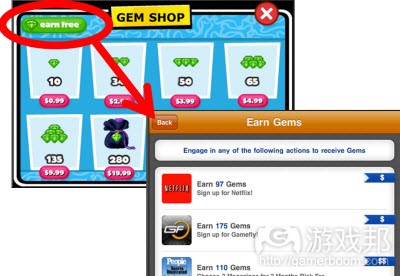每日观察:关注Android和iOS游戏IAP交易情况(8.17)
1)移动分析公司Flurry最新调查报告指出,用户在每款Android和iOS游戏中的IAP(应用内置付费功能)平均消费额达14美元;用户购买的三分之二虚拟道具属于无长久价值的易消耗产品;用户在免费游戏中最常购买的是可兑换道具的游戏虚拟货币(游戏邦注:这项调查覆盖了Android和iOS免费游戏中的5700万笔IAP交易)。
Flurry预测Android和iOS游戏今年将通过各种盈利模式创造10亿美元收益。在本项调查中,Flurry将虚拟商品分成三类:耐用品(例如装甲、建筑等)、易消耗品((例如农场游戏中的肥料,战争游戏中的手榴弹等)和个性化物品(例如装饰性的家具、植物等不含玩法元素的东西)。
2)据insidemobileapps报道,日前有传闻称Zynga已收购手机社交游戏公司Astro Ape Studios,但双方均未对此作出回应,不过已有观察者通过LinkedIn发现,Astro Ape Studios许多成员(包括其首席执行官Chieh Huang、首席创意官Christopher Cheung和首席技术官William Fong)均已获得Zynga纽约工作室的职位。
Astro Ape Studios旗下代表作包括《Dessert Heroes》和《Office Heroes》,但这几款游戏在最近几个月的应用榜单排名并不靠前,所以有人推测这应该不会是一笔数额庞大的收购交易。
3)WeFi第二季度分析报告指出,约有三分之一的Andorid手机在Wi-Fi网络每月使用流量超过100MB,而在3G网络上的同一比例仅有16%。
报告还表明,笔记本电脑用户最常浏览网页和下载内容,约有半数用户每月消耗2GB流量;多数Android移动设备每月会连接到2个以上的热点,约34%设备使用网络甚至多达10个。
WeFi还记录了同一时间连接到某个热点的设备数量,并发现有37%的热点同一时间仅连接了两部设备,这表明该网络是住宅区的Wi-Fi。仅有15%的热点同一时间连接了5台以上的设备,这属于公共场所的热点连接状况,表明公共热点仍有较大使用空间。
4)移动内容盈利解决方案供应商Tapjoy日前宣布与OMGPOP、Moblyng、Craneballs Studios、Game Circus以及Spry Fox等iOS和Android应用开发商合作,将其广告赞助支付选项植入1万多款应用中。
据Tapjoy所称,公司服务目前已覆盖全球2.5亿用户,其移动广告选项将帮助开发商推广其虚拟货币,并为新应用获取更多潜在用户。
苹果App Store在数月前宣布取缔“奖励下载模式”,但这似乎并未给Tapjoy这类推广服务供应商造成重创,该公司不久前还设立500万美元基金,支持iOS应用开发商向Android平台移植产品。
5)微软日前宣布向Windows Phone 7平台推出更多Xbox Live游戏(例如《Beards & Beaks: Cave Area》、《Bug Village》、《Burn the Rope》和《Collapse!》等)和功能,其中包括Xbox Live Avatar Awardables(可显示玩家Xbox Live虚拟形象的成就),以及购买虚拟货币或商品的功能。Windows Phone还一个家长控制系统,支持家长设置子女可观看的内容,防止他们体验成人游戏。
6)美国移动广告网络Mojiva最新调查发现,58%手机用户浏览网页时每周至少会点击一次广告。那些鼓励用户进行互动的移动广告最受欢迎,其点击比例达30%,可爱的条幅广告所占比例为20%,视频广告为18%,那些占据整个屏幕的移动广告所占比例仅为2%。
32%用户最喜欢点击来自乐队的广告,13%用户喜欢点击社交/相亲公司的广告,交通广告支持率仅1%,餐厅和酒吧广告为2%。
有48%用户称移动广告带来的影响是促使他们浏览网站,45%称这些广告促使他们下载应用,40%称广告让他们听音乐,33%称广告让他们寻找更多信息,31%称广告让他们采取购买行动。
调查指出,用户对移动广告的接受程度正在增长,但广告主需重视为用户创造者丰富的交互体验,才能获得实际的广告投放效果。
7)Hunch.com最近发布了一个iOS和Android平台对比信息图,指出iPhone用户比Android用户更富有,而后者则更为年轻(游戏邦注:该调查受访者是1万5千名Hunch用户,其中32%是iPhone使用者,21%是Android用户)。
如下图所示,在这些受访者中,Android用户的男性比例为10%,其用户主力军介于18至34岁之间,24%的Android用户家庭年均收入为5万至10万美元;而iPhone用户的女性比例为18%,有29%用户年龄超过35岁,67%用家庭年均收入达20万以上。
47%的Android用户是在2000年之后才首次接触互联网,但却有50%的iOS用户初次使用互联网的时间是在1992年之前。Android用户更注重设备的实用性,有57%受访者会选择功能齐全但外观欠佳的设备;而iOS用户却更看重产品外观,他们宁可选择时尚但功能有限的设备。
29%的Android用户喜欢存钱,而26%的iOS用户喜欢花钱;71%的Android用户习惯跟随潮流,27%的iOS用户喜欢引领潮流。(本文为游戏邦/gamerboom.com编译,如需转载请联系:游戏邦)
1)Majority of Spending in Mobile Games is on Consumable Items, Flurry Says
By Kim-Mai Cutler
Consumers who make in-app purchases in mobile games are spending most of their money on consumable goods that are used quickly to speed up gameplay or attack opponents, according to mobile analytics and monetization company Flurry.
The company categorized more than 57 million transactions across freemium iOS and Android games that on average have more than 2 million daily active users (which isn’t a large pool of titles considering the criteria). Overall, Flurry is betting that Android and iOS games will pull in $1 billion in revenue this year through all of the various revenue models from freemium to paid to advertising.
In analyzing the purchases in these larger freemium games, Flurry said that there are three main categories of goods that consumers buy:
Durable goods, which deliver a permanent benefit. Examples include armor to increase defense, or a building in a city simulation game that can increase revenue.
Consumable goods, which are depleted when used. Examples include grenades or bullets to attack opponents or virtual currency that’s used to speed up an order or task.
Personalization items, which are durable but have no gameplay element. Examples include decorative stoves, furniture or plants in a sim game.
It shouldn’t be terribly surprising to freemium game designers, considering Apple’s app store exposes the most popular items in every game.
Flurry says about two-thirds of items that players buy are consumable. The most popular type of good is a “premium” in-game currency that can be used to buy items inside an app. Again, not surprising. Anecdotally, we often see that the most popular in-app purchase items are packs of virtual currency at the $4.99 or $9.99 price points.(source:insidemobileapps)
2)Zynga Reportedly Buys Astro Ape Studios for New York Office
By Kim-Mai Cutler
Zynga reportedly bought another mobile social gaming company called Astro Ape Studios to bulk up its Android and iOS efforts.
When we first heard rumors of the deal yesterday, we reached out to Astro Ape Studios, which didn’t return requests for comment. Zynga also declined to comment. However, many of Astro Ape’s employees, including chief executive Chieh Huang, chief creative officer Christopher Cheung and chief technology officer William Fong, have all taken titles on LinkedIn at Zynga’s New York office.
Astro Ape’s titles like Dessert Heroes and Office Heroes have not been highly ranked on the overall top lists for the last few months so the price may not have been much more than the typical talent acquisition range. Office Heroes had some initial success last year, but it quickly declined afterward. Japan’s DeNA invested an undisclosed amount in Astro Ape last year.(source:insidemobileapps)
3)Android devices download more on wi-fi than 3G
by Tim Green
Study finds a third of Android phones use more than 100 MB a month on wi-fi; only 16 per cent do so on 3G.
WeFi’s Analytics report for Q2/2011 covers a host of activities relating to wi-fi data consumption. It reveals that laptop users are extremely hungry when it comes to browsing and downloading, with over half of them consuming 2GB a month.
The stats also illustrate the number of wi-fi hostpots connected per device, showing that most Androids get connected to more than two hotspots per month, with 34 per cent using up to ten different networks.
Unsurprising given that mobile users are more likely to be on the move.
WeFi also recorded the number of additional devices connected at the same time to that hotspot. In 37 per cent of cases only up to two devices are connected, which typically indicates residential Wi-Fi.
Only in 15 per cent of the cases there are more than five users connected simultaneously, which indicates public hotspots. One conclusions from this graph is that there is still a lot of rooms for public hotspots to be used for mobile data.(source:mobile-ent)
4)TapJoy Announces New Developer Partnerships, 10,000 Supported Apps
By Dan Rowinski
This post is part of our ReadWriteMobile channel, which is dedicated to helping its community understand the strategic business and technical implications of developing mobile applications. This channel is sponsored by Alcatel-Lucent. As you’re exploring these resources, check out this helpful resource from our sponsors: Cultivating a Developer Ecosystem: Understanding Their Needs
Mobile content monetization platform TapJoy announced today that it is partnering with some of the top iOS and Android application developers to help bring ad-funded payment options to more than 10,000 apps. TapJoy’s payment platform leverages virtual goods, currencies and banner ads to increase developers’ app revenues.
OMGPOP, Moblyng, Craneballs Studios, Game Circus and Spry Fox are the developers that have signed on with TapJoy. According to the TapJoy press release, the company’s partners have a global reach of 250 million consumers with 30 million daily active users. Mobile advertising options are proliferating for developers looking to leverage their virtual currencies but also acquire new users to their existing long tail of apps. The question for every app developer out there has become: “How do I get paid?” There are now more options than ever.
Last week we reported that Nexage has hit eight billion mobile impressions per month with a focus towards premium content like the National Football League, Angry Birds and the Associated Press. TapJoy does not do impressions but it does register a million completions of in-app advertising and virtual goods payments per day. Puppy World (OMGPOP) and Overkill (Craneball Studios), among others, can now enjoy an additional revenue source for apps released with the “freemium” model.
TapJoy employs a “pay per” model that rewards users for completing actions. Those actions could be downloading another application in TapJoy’s or the developer’s network, or a specific action within the application or game. TapJoy tracks these actions through a partnership with Apsalar.
Consumers do not always trust the action-reward model, though it has proven to be lucrative for developers. TapJoy has drawn the ire of Apple in the past with its “pay-per-install” practice, prompting Apple to say that TapJoy “is destroying the user experience and threatening the entire freemium model.” For apps and developers booted from the Apple App Store because of Apple’s policy changes, TapJoy set up a $5 million fund for developers to port from iOS to Android. That seems like a good publicity move for TapJoy but does not specifically help developers who had been doing well in the App Store. (source:readwriteweb)
5)Windows Phone 7 gets new Xbox Live features and 14 new games
Dean Takahashi
Microsoft previewed some new Xbox Live games and features for its Windows Phone 7 platform today at the annual Gamescom event in Cologne, Germany.
The announcements are part of the company’s plan to build enthusiasm for its mobile games — which are one of the best ways to show off its mobile platform — and the upcoming Mango release of the Windows Phone 7 software. Mango, which includes a major update for the phone software, is expected to debut in September.
It’s a small set of new features and titles, but the kind that Microsoft increasingly needs to make as it competes with rivals including Google-Motorola, Research in Motion, Nokia, Apple and Samsung in the mobile operating system market.
The new announcements include Xbox Live Avatar Awardables, which are wearable achievements for your Xbox Live avatar, or virtual character, which is visible on your phone. The first game to feature them will be the upcoming Chickens Can’t Fly.
There will also be game add-ons, such as the ability to purchase extra mushrooms and other goods in games such as Beards & Beaks. You will be able to buy more in-game add-ons and downloadable content such as extra weapons or levels in the coming months. That’s a critical feature to generate revenues for game developers.
Windows Phone will also have parental controls, where parents can set the content that kids can view. You can restrict a child from playing a mature-rated game such as the upcoming Splinter Cell Conviction game. And players will be able to do a Fast Async, which improves game play for multilayer turn-by-turn games.
Upcoming titles include Beards & Beaks: Cave Area; Bug Village (pictured); Burn the Rope; Collapse!; Chickens Can’t Fly; Gravity Guy; Farm Frenzy 2; Fight Game Rivals; IonballEX; Kinectimals Mobile; Mush; Orbital; TextTwist 2; and Toy Soldiers Boot Camp.(source:venturebeat)
6)Interactivity encourages mobile ad clicks
by Tim Green
Mojiva survey finds 30 per cent favour ads that give you something to do.
The US-based mobile ad network has just published its Mobile Audience Guide (MAG) and found that 58 per cent of those that browse the web click on an ad at least once a week.
Ads most likely to be successful were the ones encouraging interactivity (30 per cent), animated banner ads (20 per cent) and video ads (18 per cent).
At the opposite end of the scale are expanding screen take-over ads. Only two per cent favour this style.
In terms of the subject matter being advertised, 32 per cent of people are most likely to click through to an ad from a music group, followed by 13 per cent from social/dating companies and 12 per cent.
Less popular are traffic (1 per cent) and restaurants and bars (2 per cent).
When questioned about what mobile advertising prompted them to do, 48 per cent said they would browse a website, 45 per cent download an app and 40 per cent listen to music, with 33 per cent requesting more information and 31 per cent purchasing a product.
“The Mojiva MAG findings show that there is a growing acceptance of advertising in mobile by users, but it highlights the need for advertisers to make sure they are creating a rich and interactive experience for the consumer if they are to be successful,” said Amy Vale, Head of Marketing for Mojiva.
“When advertisers do so, mobile users are seeking more information and developing a loyalty towards that brand as a result.” she concluded. (source:mobile-ent)
7)What does Android,iOS say about you?
by Marin Perez
Our friends over at Hunch have put together an infographic about what your platform of choice says about you and, in general, it says that iPhone owners have more money, are well-traveled and are early adopters. Android users are generally more pessimistic, like The Walking Dead and are younger than iPhone users.
Of course, this is based on more than 15,000 Hunch users and the service itself aims to find out what your interests are and how that’s related to other things. It should be noted that its user base might be skewed, as 32 percent of respondents used an iPhone while only 21 percent of users had an Android phone. In the larger U.S. smartphone market, more people use Android than iOS.
There are some other interesting things in this infographic and feel free to see if these match up with your characteristics. (source:intomobile)



























.jpg)




















 闽公网安备35020302001549号
闽公网安备35020302001549号